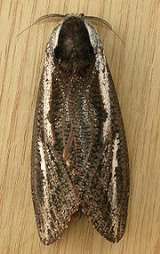
Endoxyla leucomochla
Encyclopedia
Endoxyla leucomochla is a species of cossid moth
endemic to Australia
. The larvae of the moth is commonly known as the "witchetty grub
", and was widely used as bushfood
by Indigenous Australians
.
The caterpillars of the species live in underground tunnels where they feed on the sap from the roots of the witchetty bush (Acacia kempeana
) and the small cooba (Acacia ligulata). The caterpillar grows to a length of about 7 cm, and pupa
tes underground inside its tunnel.
The adult moth is large (it has a wingspan of about 16 cm), with a fine mottled grey pattern and rusty red base on its wings. The moth has degenerate mouthparts, and is unable to feed itself, relying solely on nourishment obtained during its larval phase.
Cossidae
Cossidae, the cossid millers or carpenter millers, make up a family of mostly large miller moths. Ths family contains over 110 genera with almost 700 known species, and many more species await description...
endemic to Australia
Australia
Australia , officially the Commonwealth of Australia, is a country in the Southern Hemisphere comprising the mainland of the Australian continent, the island of Tasmania, and numerous smaller islands in the Indian and Pacific Oceans. It is the world's sixth-largest country by total area...
. The larvae of the moth is commonly known as the "witchetty grub
Witchetty grub
The witchetty grub is a term used in Australia for the large, white, wood-eating larvae of several moths...
", and was widely used as bushfood
Bushfood
Bushfood traditionally relates to any food native to Australia and used as sustenance by the original inhabitants, the Australian Aborigines, but it is a reference to any native fauna/flora that is used for culinary and/or medicinal purposes regardless of which continent or culture it originates...
by Indigenous Australians
Indigenous Australians
Indigenous Australians are the original inhabitants of the Australian continent and nearby islands. The Aboriginal Indigenous Australians migrated from the Indian continent around 75,000 to 100,000 years ago....
.
The caterpillars of the species live in underground tunnels where they feed on the sap from the roots of the witchetty bush (Acacia kempeana
Acacia kempeana
Acacia kempeana , commonly known as wanderrie wattle, witchetty bush or granite wattle, is a shrub in subfamily Mimosoideae of family Fabaceae...
) and the small cooba (Acacia ligulata). The caterpillar grows to a length of about 7 cm, and pupa
Pupa
A pupa is the life stage of some insects undergoing transformation. The pupal stage is found only in holometabolous insects, those that undergo a complete metamorphosis, going through four life stages; embryo, larva, pupa and imago...
tes underground inside its tunnel.
The adult moth is large (it has a wingspan of about 16 cm), with a fine mottled grey pattern and rusty red base on its wings. The moth has degenerate mouthparts, and is unable to feed itself, relying solely on nourishment obtained during its larval phase.

